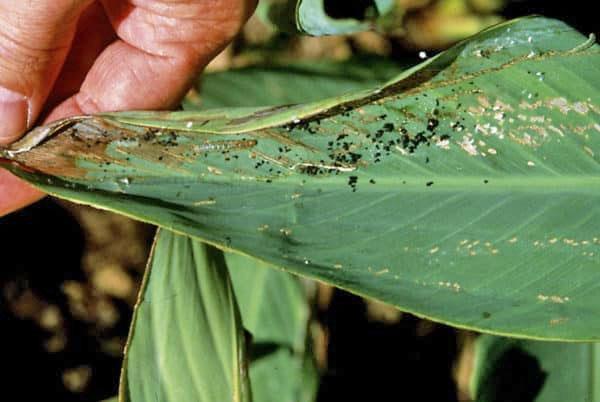Cannes viral and fungal diseases: great deliverance
 Plants are like humans. When they are healthy, they delight others, but as soon as an ailment approaches them, everything goes downhill. Canna diseases manifest themselves in different ways. The cause of their occurrence is improper care of the flower bed. Therefore, the main duty of a grower is to create suitable conditions for growing a crop. Then his duties are reduced to recognizing the first signs of danger. Then he begins a complex mission of getting rid of the captivity of microorganisms.
Plants are like humans. When they are healthy, they delight others, but as soon as an ailment approaches them, everything goes downhill. Canna diseases manifest themselves in different ways. The cause of their occurrence is improper care of the flower bed. Therefore, the main duty of a grower is to create suitable conditions for growing a crop. Then his duties are reduced to recognizing the first signs of danger. Then he begins a complex mission of getting rid of the captivity of microorganisms.
Before transferring a specimen to open ground, a special awakening and germination procedure must be carried out. Otherwise, the gardener will not wait for huge buds in the garden.

Dangerous diseases of cannes
This type of plant is least susceptible to viruses, parasites and bacteria. Nevertheless, if this happens, then you have to remove and then burn the affected parts of the bushes. In this review, 2 types of common diseases are proposed for consideration.
Deadly viruses
 One of them is the cucumber mosaic. Aphids serve as companions in the spread of viral infection. Insects are attracted by the fumes released by sick specimens. Moving to healthy plants, they carry with them a deadly virus that appears as filamentous formations on leafy plates. You can deal with it with the following methods:
One of them is the cucumber mosaic. Aphids serve as companions in the spread of viral infection. Insects are attracted by the fumes released by sick specimens. Moving to healthy plants, they carry with them a deadly virus that appears as filamentous formations on leafy plates. You can deal with it with the following methods:
- remove aphids / larvae mechanically or with soapy water, in case of emergency - with chemicals;
- cut off affected leaves;
- to clear the bed of weeds, especially sow thistle;
- carry out preventive measures.
Washing the leaves with a soap solution should be extremely careful. If the liquid gets on the ground, the root system gets fatal burns.
 The last point also includes regular inspection of the planting and disinfection of garden tools. It is important to know that the keepers of viruses are cultivated plants:
The last point also includes regular inspection of the planting and disinfection of garden tools. It is important to know that the keepers of viruses are cultivated plants:
- zinnia;
- gladioli;
- phlox;
- dahlias.
Another reason why canna leaves dry out is a too dry microclimate and a lack of moisture. If the soil is too dense, not loose, then the flower should be transplanted to another area.
 However, these symptoms should not be confused with variegation. It manifests itself as black dots that develop over time to brown streaks and hideous spots. This merciless canna disease leads to severe deformation, as well as a decrease in the size of the culture. The damaged part is cut off with a decent margin.
However, these symptoms should not be confused with variegation. It manifests itself as black dots that develop over time to brown streaks and hideous spots. This merciless canna disease leads to severe deformation, as well as a decrease in the size of the culture. The damaged part is cut off with a decent margin.
It's only one step from a petty dispute to a colony
 Pathogenic microorganisms successfully infect many cultivated varieties. Sadly, fungal diseases cannot be cured. The best way to deal with them is to prevent them from occurring.
Pathogenic microorganisms successfully infect many cultivated varieties. Sadly, fungal diseases cannot be cured. The best way to deal with them is to prevent them from occurring.
Agronomists advise digging up the beds for the winter and choosing weeds that carry fungal spores. Then burn the waste. In addition, siderates should be sown - white mustard or lupine.
The main blow is to be expected from the rusty fungus. The foliage in the blink of an eye becomes covered with a brown bloom that resembles rust.As a result, the bush dries up completely and sheds its leaves. You can't hesitate in such situations:
- The first step is to cut out the affected leaves.
- Treat the area abundantly with a warm solution of potassium permanganate. For a bucket of liquid, up to 4-5 g of powder.
- Repeat the procedure after a couple of days.
 Yellow spots are the first harbingers of the presence of fungal colonies. You need to know that the disease progresses with high humidity, as well as stagnant water, especially near the root neck.
Yellow spots are the first harbingers of the presence of fungal colonies. You need to know that the disease progresses with high humidity, as well as stagnant water, especially near the root neck.
To avoid waterlogging of the land, it is recommended to follow the basic irrigation technology. After rain or irrigation, the bed is well loosened, which helps moisture penetrate into the lower layers of the soil.
Horrific Rot
 The second danger to cannes is from gray rot. Favorable conditions for the development of the fungus Botrytis are an increase in humidity in combination with a decrease in temperature. The first manifestations in the form of a gray bloom are observed on stems, flowers and buds. Over time, these parts soften and darken. But the tips of the leaves acquire a brownish edging and generally die off. It is possible to prevent the development of fungal spores if:
The second danger to cannes is from gray rot. Favorable conditions for the development of the fungus Botrytis are an increase in humidity in combination with a decrease in temperature. The first manifestations in the form of a gray bloom are observed on stems, flowers and buds. Over time, these parts soften and darken. But the tips of the leaves acquire a brownish edging and generally die off. It is possible to prevent the development of fungal spores if:
- control content nitrogen in the soil (a concentrate of compounds makes the culture susceptible to infections);
- pluck young weeds;
- watering at the very root;
- when planting, observe the specified distance, thereby avoiding thickening;
- apply top dressing on time, adhering to the proposed dosage.
 By soaking the seedlings in special solutions, you can strengthen the plant's immunity. During the budding / formation period, it is important to spray the planting with growth stimulants or protective agents.
By soaking the seedlings in special solutions, you can strengthen the plant's immunity. During the budding / formation period, it is important to spray the planting with growth stimulants or protective agents.
But there is still no flowering
 It is not difficult to grow luxurious flowers in the southern latitudes. However, even in such a favorable environment, many are confused as to why the canna does not bloom. The whole reason is in climatic conditions that are often not suitable for her. All that a gardener can do is to provide the plant with decent care:
It is not difficult to grow luxurious flowers in the southern latitudes. However, even in such a favorable environment, many are confused as to why the canna does not bloom. The whole reason is in climatic conditions that are often not suitable for her. All that a gardener can do is to provide the plant with decent care:
- Plant in sunny areas, preferably without drafts. Shady places depress culture.
- Put rotted manure or compost into the planting hole. During the growing season, feed with fermented grass or potassium-phosphorus complexes.
- The soil should be selected extremely loose and not dense. Regularly, and most importantly, moderately moisturize it.
- Conduct systematic prophylaxis against pests, since diseased specimens never bloom.
Compliance with watering standards, maintaining temperature and humidity is always important to put at the forefront. In addition, flowering cannot be expected without a preliminary awakening procedure and subsequent germination. If you plant a crop immediately on a flower bed, then, apart from lush greenery, there will be nothing else.
As you can see, canna diseases are dangerous and varied, but they cannot be called insurmountable. A competent approach to business, as well as a sharp-sighted eye of a detective, will help the gardener to notice dangers in the early stages.